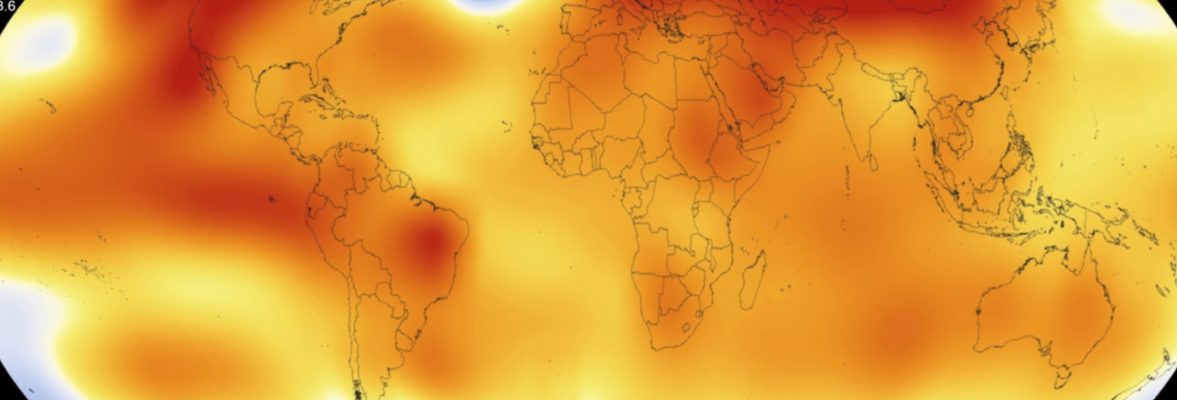Get Past Global Warming: The Future Needs Global Cooling
25,000 people from 197 countries attended the just-concluded UN Climate Change Conference of the Parties (COP26) in Glasgow. Heads of state, Nobel laureates, and celebrities made solemn pronouncements. Corporate leaders touted green commitments. All urged the world to achieve net-zero carbon emissions by 2050. A nasty problem was little discussed, partly because there is no clear solution. We need the planet to get cooler: reaching net-zero emissions will not do that.
Earth Needs to Cool Off
This July was the warmest month ever recorded. If net-zero emissions is achieved by 2050, every July for the next 30 years will likely be hotter. Carbon dioxide in particular, CO2, which detailed models show is directly responsible for much of global warming, stays in the atmosphere for thousands of years. Even if we reach net-zero CO2 emissions in 2050, another 30 years of CO2 will be added to the industrial era’s cumulative spew. As of 2020, global temperatures had risen 1.2oC from 1850, the start of the industrial era. Achieving net-zero emissions by 2050 adds another 0.3oC of warming. For the next thirty years, storms will become increasingly violent. Even after global warming stops sea levels will continue to rise for years as ice sheets melt away.
We don’t need just to stop Earth from getting warmer, we need it to cool off.
McKinsey projects that with just that additional 0.3oC rise above pre-industrial levels, 800 million more people will face severe climate extremes including heat stress, urban water shortages, flooding, and drought. People will suffer, and mass migration to cooler northern climates like the EU and North America, will intensify. We don’t need to just stop Earth from getting warmer, we need it to cool off. Yet many observers think a result of COP26 is that the 1.5oC goal has been abandoned, and we will see warming of 1.8oC or higher by 2050. How might we achieve Global Cooling? World-wide impact and potentially trillions of dollars of revenue are at stake.
Global Warming is Real. Global Cooling Can be, Too
A shrinking but fervent cohort of skeptics still issue quips like, “There are only trace quantities of CO2 in the atmosphere. It can’t have any impact on global temperatures.” Yes, CO2 is a measly 0.04% of our atmosphere, and it’s invisible. But chemistry, physics, and big data deliver the inescapable conclusion that CO2, the gas that is the fun and friendly fizz in our soda pop, has a dark side. Here’s how it works. The sun heats our planet. Things on the Earth get warm, and in cooling off they literally send out infrared radiation, which we feel as heat. Because of how the CO2 molecule is put together, it reflects infrared rays in totally random directions. So, half of the heat that runs into a CO2 molecule goes back down to Earth instead of out into space. Contrast that with nitrogen, which makes up 78% of our air, and oxygen, which makes up 21%: infrared goes right through them. But CO2 is still just 0.04% of the atmosphere: how can it matter? Big data, which teases out slight currents in seas of information, gives the answer. The Intergovernmental Panel on Climate Change, the IPCC, is the UN’s scientific arm for climate change. The IPCC uses big data to model the Earth’s relationship with CO2. The results are clear: when the CO2 in the atmosphere goes up, so does the temperature.

Trace quantities have outsized impacts in complex systems. Think about having a couple drinks. When your blood alcohol content reaches the trace quantity of 0.08% you’ll be legally intoxicated. (The average person only needs to drink two beers in an hour to get there.) The modeling process’ size, detail, and transparency are stunning. The latest revision involved 234 authors and editors, 78,000 comments, and 14,000 citations. (See the IPCC model creation history: here, final page). One must contort logic to conclude that the model is fraudulent, done in secret, or that legitimate objections have been squelched. No one likes the numbers, but they are what they are. The job now is to work on solutions.
Global Cooling Numbers
How much CO2 do we have to purge from the atmosphere to cool our planet, and how can we do it? To just peak at 1.5oC, the IPCC targets removing an additional 100 to 1000 gigatons (Gt) of atmospheric CO2 this century (Point C3, p. 17, here). One gigaton is equal in mass to about 3,000 Empire State Buildings. Nature ingeniously removes atmospheric CO2 by turning it into leaves, wood, and bark. Human ingenuity is the other option. Nature is hard to beat: planting trees is two orders of magnitude less expensive at removing CO2 than today’s technical innovations. But, planting trees has unavoidable limitations. First, we would have to plant and grow new trees on currently tree-less land the size of Australia or Brazil(1). Second, because it costs roughly $1,000 to plant an acre of trees, the bill will run $2 trillion.
Global Cooling by Growing Energy
Instead of just growing plants and trees once, how about harvesting them for energy then growing them again? It is an elegant idea: the nomenclature is “Biomass energy with Carbon Capture and Sequestration,” or BECCS. The critical step is scrubbing CO2 from power plant emissions so that less CO2 goes back into the atmosphere than the plants-turned-fuel pulled out. However, BECCS has the same limitation as growing trees: it needs too much land. 40% of global cropland would have to be devoted to BECCS to remove sufficient CO2 from our atmosphere (here, p. 3). It can only be a piece of a total solution.
Technical Options for Removing CO2
If $2T per year and a dedicated continent’s worth of arable land with sufficient water is the best-known solution, what are some other options? Two pilot projects substantiate that technology can extract CO2, likely at scale. Switzerland’s Climeworks, with $110M of investor funding, runs fifteen CO2 extraction facilities worldwide. Their newly opened commercial plant in Hellisheiði, Iceland, named “Orca,” can capture 4,000 metric tons of CO2 a year, and they plan a facility with 10X that capacity three years from now. Financers include Swiss bank Zuercher Kantonalbank and Microsoft’s climate innovation fund. Canada’s Carbon Engineering has a six-year-old pilot plant in Squamish, BC. Investors include Bill Gates, Occidental Petroleum, Chevron, and BHP. Both companies employ giant fans to push air through proprietary CO2-capturing filters. Both have similar cost targets of $100 to $150 per ton of CO2 when operating at scale. That is 10X the typical cost estimate via planting trees, $10 per ton of CO2.

Despite the risks and high costs of new technologies, direct air capture has a factory-like footprint. Our atmosphere’s global commons circulates everywhere; these factories can also be located anywhere on the globe.
Global Cooling by Terraforming-Lite
The gulf between pressing needs and known solutions begs for out-of-the-box ideas. In the case of Global Cooling, out-of-the-box wafts into the bizarre. Science fiction writers have long tantalized readers with terraforming, creating a livable atmosphere on another planet. Solar geoengineering is an eerily similar concept. It is the opposite of CO2 removal: instead of allowing heat to leave our planet, solar geoengineering’s thesis is stopping sunlight from getting here in the first place. There are two frequently discussed solar geoengineering concepts: Stratospheric Aerosol Injection (SAI) and Marine Cloud Brightening (MCB). Each potentially costs so little that even developing nations could deploy them. Neither is proven, but SAI has a well-understood natural cousin: volcanoes. SAI purposely releases chemicals into the stratosphere. There, either directly or through reactions, they form tiny particles that reflect sunlight. The 1991 Mt. Pinatubo eruption sent 15 million tons of sulfur dioxide 40km up into the sky. Over the next 15 months, Earth’s average temperature decreased by about 0.6C. The particles stayed up there for two years. A recent analysis suggests that we can recreate that cooling for only $2 billion annually with specially designed high-altitude airplanes. If you suspect that injecting mass quantities of sulfur into the atmosphere may have unwanted side effects, you are not alone. The same tiny particles cause Los Angeles’ infamous haze. Increased disease and mortality caused by fine sulfate particulates are driving reasons for removing sulfur from gasoline and engine exhaust. A 20-year EPA air quality engineer noted to me, “You don’t have to wait long. With more fine particulates, mortality goes up right away.” SAI may also bring unpredictable side effects on weather. One study strongly suggests that tropical volcanic eruptions disrupt monsoon rains, and significantly impact rainfall distribution and water resources. How about Marine Cloud Brightening (MCB)? The concept is cooling the Earth by making the clouds over the oceans brighter, thus more reflective. One approach is spraying a fine mist of saltwater into the ocean-atmosphere. Application can be local, for example, over a vulnerable habitat or shore population. Locality is also a limitation. Impacting warming globally via MCB would require deployment in numerous locations. Solar geoengineering is a planetary-scale example of “Break Glass in Case of Emergency.” Yet as our planet heats up and extreme weather events become more common, and without other Global Cooling solutions, we may be forced into awful choices between mortality caused by warming and mortality caused by the tools that we use to reverse it.
Great Need Means Great Opportunity
Planting trees and growing energy biomass are attractive, but insufficient. Proposed technical innovations are either massively too expensive or more fitting in a dystopian thriller than our one and only habitable biosphere. There is immense opportunity for new ideas. A system that captures atmospheric carbon with the cost of planting trees and the footprint of industrial systems, like those from Carbon Engineering and Climateworks, will be a social and commercial blockbuster. 2050 market size estimates for direct carbon removal range from $500B to $1.4T. Jos Delbeke, chair of climate change policy at the European Investment Bank, envisions a decade of massive investment in carbon capture and storage technologies and zero-emission fuels like green hydrogen (hydrogen made with renewable energy). Influential investors are piling in. Last month Al Gore, the former U.S. Vice President, with backing from Microsoft, Goldman Sachs, and Ireland’s sovereign wealth fund, launched “Just Climate.” This asset management fund will invest in solutions to limit Global Warming to 1.5oC. In February, Elon Musk funded the largest incentive prize in history, a $100 million “XPrize,” to attract inventions for carbon removal systems. Early ideas entered in the competition are novel and varied, including:
- Growing algae in reactors located in deserts, or on ships at sea, turning CO2 into plant matter on an industrial scale and without using agricultural land.
- Freezing CO2 out of the air or “desubliming” it into dry ice.
- Crowd-harvesting of CO2 removal via a cryptocurrency that rewards individuals for capturing CO2. The world’s population would get paid to maintain the global commons by, for example, planting trees at home.
Where Will the Money Come From?
Global Cooling systems can generate revenue by generating energy, like BECCS, or by using renewable sources to synthesize carbon-based fuels from captured CO2. It may seem self-defeating to create kerosene for jet engines, or ethanol for internal combustion engines from captured CO2. So much energy is packed in a kilo of petrol that it is the only realistic way to power some critical machines, like jumbo jets. However, the long-term market for carbon-based power alone will not finance long-term carbon capture. The Cap-and-trade finance scheme leverages market forces to drive down carbon emissions. Governments set caps for the quantity of CO2 that a company, like a power plant, can emit. The caps are framed as credits given to the company: one credit equals a quantity of emissions (one metric ton of CO2 in the EU’s program). Companies openly buy and sell credits. If one company finds a way to cut its emissions, it can sell is credits to those who exceed their caps. The market price for credits settles at less than government-set excess emissions penalties. The EU has used cap-and-trade since 2005, and claims 21% reduced emissions. In a controversial program challenged by experts, California enables forestland owners to sell credits on its carbon market. Setting annual emission limits and values for captured CO2 are complex problems. Fundamentally, the schemes amount to taxes used to improve our planet’s air. Ultimately, taxes will fund CO2 reduction. All over the world, people pay taxes for sewage treatment plants. CO2 is invisible, odorless sewage for our global climate: a global tax for CO2removal is a fitting solution.
The Global Cooling Opportunity Is Unbouned
Climate science is frightfully complex, but there is one constant truth: the more CO2 pulled from the air, the cooler our Earth will be. It is a giant problem; thus it is an incredible business and impact opportunity for teams who can deliver creative solutions. Global Cooling is an unbounded problem: the need stretches for thousands of years. Brainstorm about disruptive Global Cooling solutions, and the teams and funding that you need to execute them. And while you’re planning, plant a tree.
Cover Image
Earth’s 2015 surface temperatures were the warmest since modern record keeping began in 1880, according to independent analyses by NASA and the National Oceanic and Atmospheric Administration (NOAA). Public domain image: http://www.nasa.gov/sites/default/files/thumbnails/image/16-008.jpeg
Calculations
(1) Here’s the math. Set the CO2 removal target at 400Gt, in the middle third of the IPCC’s range. 200 acres of new forest pulls 1,000 tones of CO2 from the atmosphere in a year. 80 years remain until the end of the century (A small simplification so one can actually do the math in one’s head). Assume that we plant trees evenly over time (That’s another small simplification, but it doesn’t make a large difference.). The first year starts with no new trees, which remove 0 CO2. The trees have to average 5Gt of CO2 removed per year (400/80). With 0 CO2 removed at the start we’ll need to plant enough new trees to remove 10Gt CO2 in year 80 to average 5Gt of CO2 removed per year.
- 200,000,000 newly planted acres pull a gigaton per year: 2,000,000,000 acres sequester 10Gt per year.
- That’s 3,125,000 square miles, about 2X the size of India, or around the size of Australia or Brazil.




